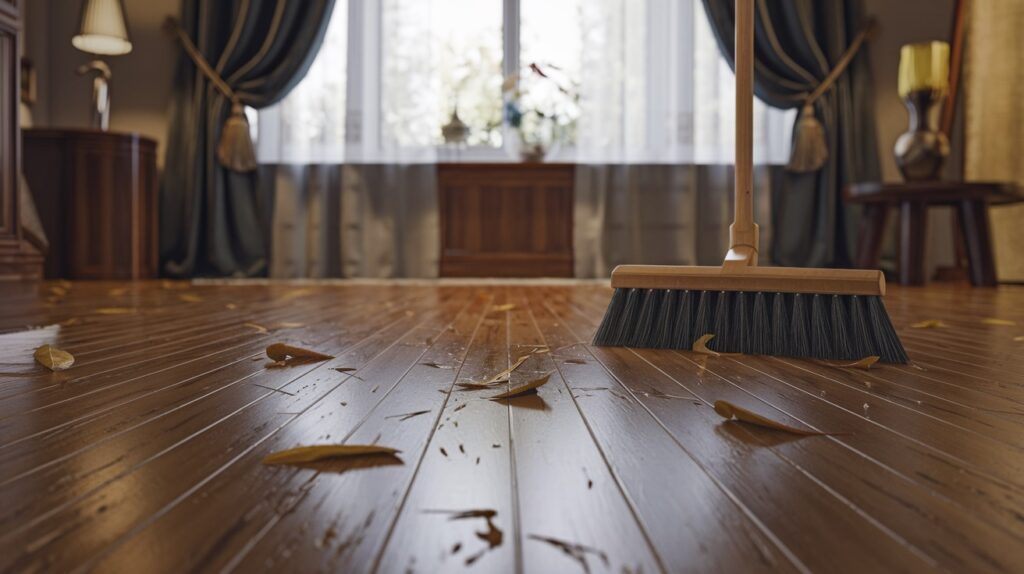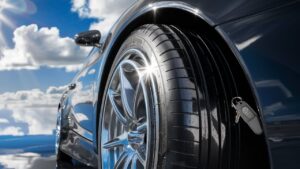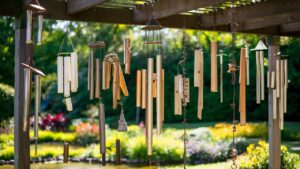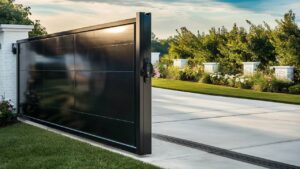To clean hardwood floors safely, use a damp microfiber mop and a pH-balanced cleaner specifically designed for wood. Avoid excessive water and harsh chemicals to prevent damage.
Hardwood floors add warmth and elegance to any home. Proper cleaning is essential to maintain their beauty and longevity. Dust, dirt, and grime can accumulate over time, dulling their finish. Using the right cleaning techniques helps preserve the floor’s natural shine and protects the wood from scratches and water damage.
Regular maintenance not only enhances appearance but also prevents costly repairs. Understanding the best products and methods can make a significant difference. This guide will provide effective strategies for cleaning hardwood floors safely, ensuring they look stunning for years to come. Let’s explore the best practices for maintaining your beautiful hardwood floors.
Introduction To Hardwood Floor Care
Cleaning hardwood floors requires special attention. Proper care keeps your floors looking beautiful. It also extends their lifespan. Knowing the right techniques is essential for maintenance.
Importance Of Proper Cleaning
Cleaning hardwood floors properly has many benefits:
- Enhances Appearance: Regular cleaning keeps floors shiny.
- Prevents Damage: Dirt can scratch the surface.
- Improves Longevity: Well-maintained floors last longer.
- Promotes Health: Clean floors reduce allergens.
Using the right cleaning products is crucial. Avoid harsh chemicals. They can damage the finish. Use pH-balanced cleaners instead. Always test a small area first.
Common Challenges
Cleaning hardwood floors comes with its own challenges:
| Challenge | Solution |
|---|---|
| Scratches | Use felt pads under furniture. |
| Water Damage | Wipe spills immediately. |
| Stains | Use a mixture of vinegar and water. |
| Dirt Build-Up | Regular sweeping or vacuuming. |
Understanding these challenges helps in effective cleaning. Regular maintenance prevents larger issues. Choose the right tools for your cleaning routine.
Identifying Your Hardwood Finish
Knowing your hardwood floor’s finish is essential. Different finishes require specific cleaning methods. Use the wrong method, and you may damage your floor. Here are the main types of finishes.
Surface-sealed Floors
Surface-sealed floors have a protective layer on top. This layer prevents moisture from penetrating the wood. Common types include polyurethane and acrylic finishes.
- Easy to clean with a damp mop.
- Use a pH-neutral cleaner for best results.
- Avoid oil-based cleaners that can damage the finish.
Penetrating Seal-treated And Oil-treated Floors
These floors absorb products into the wood. They are often treated with oils or waxes. This finish needs regular maintenance.
- Use a soft cloth for cleaning.
- Apply a suitable wood cleaner for penetrating finishes.
- Re-oil or wax every few months to maintain appearance.
Lacquered, Varnished, Shellacked, And Untreated Floors
These finishes are less common but still important. They offer varying levels of protection. Each has unique cleaning needs.
| Finish Type | Cleaning Method | Maintenance Tips |
|---|---|---|
| Lacquered | Use a damp cloth or mop. | Avoid abrasive cleaners. |
| Varnished | Use a gentle cleaner. | Reapply varnish every few years. |
| Shellacked | Clean with a soft cloth. | Apply shellac as needed. |
| Untreated | Dust regularly with a soft broom. | Consider treating for protection. |
Understanding your hardwood finish helps you clean effectively. Follow these tips to keep your floors looking great.
Daily Hardwood Floor Maintenance
Maintaining hardwood floors daily keeps them beautiful and lasting. Regular care prevents dirt buildup. This helps avoid deep cleaning tasks. Simple daily habits ensure your floors shine.
Sweeping Techniques
Using the right sweeping techniques makes a big difference. Follow these steps for effective sweeping:
- Choose the right broom: Use a soft-bristle broom.
- Start at one corner: Sweep towards the center.
- Use gentle strokes: Avoid aggressive sweeping.
- Don’t forget edges: Clean corners and baseboards.
By following these techniques, you reduce scratches. Regular sweeping prevents dirt from scratching the surface.
The Role Of Dust Mopping
Dust mopping complements sweeping. It captures fine dust and particles. Use a microfiber mop for the best results. Here’s how to dust mop effectively:
- Ensure the mop is clean.
- Move in a figure-eight pattern.
- Pay extra attention to high-traffic areas.
- Change the mop pad as needed.
Dust mopping daily keeps your floors looking new. It also protects the finish from wear. Always remember to store your mop properly after use.
Deep Cleaning Strategies
Deep cleaning hardwood floors keeps them looking new. Regular cleaning removes dirt and dust. Use specific strategies for a thorough clean. This guide shows you how to deep clean safely.
Choosing The Right Cleaner
Selecting the right cleaner is crucial. Use products designed for hardwood floors. Avoid harsh chemicals that can damage the finish.
- Look for pH-balanced cleaners.
- Choose natural or eco-friendly options.
- Check for labels that say “safe for hardwood.”
Test any cleaner in a small area first. This helps ensure it won’t harm your floor.
Mopping With Care
Mopping hardwood floors requires special attention. Use a damp mop instead of a soaking wet one. Excess water can warp the wood.
- Start in a corner and move toward the exit.
- Use a microfiber mop for better dirt pickup.
- Change the water frequently to avoid spreading dirt.
After mopping, allow the floors to dry completely. This prevents moisture damage.
Tackling Tough Stains
Stains can be stubborn on hardwood floors. Use the right methods to remove them.
| Stain Type | Cleaning Method |
|---|---|
| Food and Drink | Use a mixture of vinegar and water. |
| Pet Urine | Blot with a cloth, then use an enzyme cleaner. |
| Scuff Marks | Rub with a soft eraser or a tennis ball. |
Always rinse the area after cleaning. This removes any leftover cleaner. Dry the spot with a soft cloth.
Preventing Water Damage
Water can cause serious damage to hardwood floors. Understanding how to prevent it is essential for maintaining their beauty and longevity. Simple actions can help protect your floors from moisture-related issues.
Why Water Is A Hardwood Foe
Water can warp, stain, or ruin hardwood floors. Here are some key reasons why:
- Absorption: Wood absorbs moisture easily.
- Expansion: Excess water makes wood expand.
- Contracting: Drying causes wood to contract.
- Stains: Water can leave ugly stains.
- Mold: Moisture encourages mold growth.
Best Practices For Mopping
Keeping hardwood floors clean requires careful mopping. Follow these best practices:
- Use a damp mop: Avoid soaking the mop.
- Choose the right cleaner: Use a pH-neutral cleaner.
- Work in sections: Mop small areas at a time.
- Dry immediately: Wipe up any excess moisture.
Consider using a microfiber mop. It holds dirt without scratching. Regularly check your mop for dirt buildup.
| Tip | Description |
|---|---|
| Use Soft Cloths | Choose soft cloths to avoid scratches. |
| Vacuum Regularly | Remove dirt before mopping. |
| Avoid Excess Water | Never pour water directly on the floor. |
These practices keep your hardwood floors safe and beautiful. Protect your investment with careful cleaning.
Scratch And Scuff Mark Removal
Scratches and scuff marks can ruin the beauty of your hardwood floors. Luckily, removing these blemishes can be simple. Using the right methods helps maintain the floor’s shine.
Diy Solutions
Many household items can help you fix scratches and scuffs. Here are some effective DIY solutions:
- Olive Oil and Vinegar: Mix equal parts. Apply with a soft cloth.
- Crayon or Furniture Marker: Choose a color that matches your floor. Rub over the scratch and blend.
- Baking Soda Paste: Mix baking soda with water. Apply gently to the scratch.
- Walnut: Rub the meat of a walnut over the scratch. It fills in the gap.
Try these methods on a small area first. Always use a soft cloth to avoid further damage.
Professional Repair Tips
Sometimes, professional help is best for deeper scratches. Here are tips from experts:
- Assess the Damage: Check if it needs sanding or refinishing.
- Use a Professional Repair Kit: Get a kit designed for hardwood floors.
- Hire a Specialist: Look for local experts with good reviews.
- Consider Refinishing: This restores the floor’s original beauty.
Taking swift action on scratches helps your floors last longer. Keeping your hardwood floors looking great is easy with these tips.
Protecting Hardwood Floors From Furniture Damage
Hardwood floors are beautiful but vulnerable. Furniture can scratch, dent, or leave marks. Protecting these floors from damage is essential. Simple steps can keep your floors looking new. Follow these tips for better protection.
Using Floor Protectors
Floor protectors are a must for safeguarding hardwood floors. They come in various forms. Here are some effective options:
- Felt pads: Stick them under furniture legs.
- Rubber protectors: Use these for heavy items.
- Furniture coasters: Great for moving furniture easily.
Choose the right size for your furniture. Replace worn-out protectors regularly. This helps maintain their effectiveness.
The Importance Of Rugs And Mats
Rugs and mats are excellent for preventing damage. They act as barriers between furniture and floors. Consider these tips:
| Type of Rug | Benefits |
|---|---|
| Area Rugs | Cover large spaces and reduce scratches. |
| Door Mats | Trap dirt and moisture before entering. |
| Runner Mats | Protect hallways from wear and tear. |
Choose rugs with non-slip backing. This keeps them in place. Regularly clean your rugs to avoid dirt buildup. This helps in maintaining the beauty of your hardwood floors.
The Don’ts Of Hardwood Floor Cleaning
Cleaning hardwood floors requires special care. Some common mistakes can damage the wood. Avoiding specific products and methods helps maintain your floors.
Products To Avoid
Using the wrong products can harm your hardwood floors. Here’s a list of items to steer clear of:
- Ammonia-based cleaners: They can dull the finish.
- Oil soaps: They leave a slippery residue.
- Vinegar: It can strip away the protective layer.
- Bleach: It may discolor the wood.
- Wax: It builds up and makes floors sticky.
Common Cleaning Mistakes
Avoid these common mistakes to keep your floors safe:
- Using too much water: Excess water can warp the wood.
- Scrubbing too hard: This can scratch the surface.
- Ignoring spills: Clean spills immediately to prevent stains.
- Using a vacuum with a beater bar: This can damage the finish.
- Not using a microfiber mop: Other mops can leave dirt behind.
Keep these tips in mind. They will help maintain the beauty of your hardwood floors.
Advanced Hardwood Floor Care
Maintaining your hardwood floors goes beyond basic cleaning. Advanced care keeps them looking beautiful and extends their lifespan. Two main processes include polishing and buffing, plus knowing when to refinish.
Polishing And Buffing
Polishing and buffing are essential for restoring shine. These methods remove minor scratches and scuffs. They also enhance the floor’s protective layer.
- Polishing: Use a high-quality hardwood floor polish.
- Buffing: Use a buffing machine for best results.
Follow these steps for effective polishing and buffing:
- Clean the floor thoroughly.
- Apply the polish evenly.
- Use a buffing machine or cloth.
- Let it dry completely before walking on it.
Polish once every 3-6 months. Buffing can be done every year.
When To Refinish
Refinishing restores your floor’s original beauty. Signs that refinishing is needed include:
- Visible scratches.
- Faded areas.
- Water damage.
Consider refinishing every 3-5 years. The process involves:
- Sand the floor to remove the old finish.
- Repair any damaged boards.
- Apply a new finish.
Always hire a professional for best results. Proper care keeps your hardwood floors stunning and durable.
Seeking Professional Help
Cleaning hardwood floors requires care and expertise. Sometimes, hiring a professional is the best option. They have the right tools and knowledge. This ensures your floors remain beautiful and undamaged.
When To Call In The Experts
Some situations call for expert help. Here are signs you should consider:
- Deep Scratches: Visible damage that cleaning can’t fix.
- Discoloration: Uneven color or faded areas on the floor.
- Water Damage: Signs of warping or swelling from moisture.
- Stubborn Stains: Marks that won’t come off with regular cleaning.
- Old Floors: Hardwood floors that haven’t been maintained for years.
Selecting A Hardwood Floor Cleaning Service
Choosing the right service is crucial. Follow these steps:
- Research: Look for local companies with good reviews.
- Ask Questions: Inquire about their cleaning methods and products.
- Get Estimates: Compare prices from multiple services.
- Check Credentials: Ensure they are licensed and insured.
- Read Contracts: Understand what services are included.
Here’s a quick comparison of common services:
| Service Type | Pros | Cons |
|---|---|---|
| Steam Cleaning | Deep clean, eco-friendly | May cause water damage |
| Dry Cleaning | Less moisture, quick drying | Can be costly |
| Buffing and Polishing | Restores shine, less invasive | Not for deep stains |
Eco-friendly And Diy Cleaning Solutions
Cleaning hardwood floors safely is important. Eco-friendly and DIY cleaning solutions help maintain their beauty. These options are safe for your family and pets. They also protect the environment.
Natural Cleaning Agents
Natural cleaning agents are effective and safe. Here are some popular options:
- Vinegar: Cuts through dirt and grime.
- Baking Soda: Helps remove stains and odors.
- Olive Oil: Adds shine and nourishment.
- Essential Oils: Provide a pleasant scent and antibacterial properties.
Homemade Cleaners Recipes
Making your own hardwood floor cleaner is easy. Here are some simple recipes:
| Ingredients | Instructions |
|---|---|
| 1 cup vinegar 1 gallon water |
Mix in a bucket. Mop the floor gently. |
| 1 cup olive oil 1/2 cup vinegar 10 drops essential oil |
Combine in a spray bottle. Shake well. Spray and wipe. |
| 1/2 cup baking soda 1 gallon water |
Dissolve baking soda in water. Mop the floor. |
These recipes are simple and cost-effective. They keep your floors clean without harmful chemicals. Enjoy a fresh, sparkling finish!

Frequently Asked Questions
How Often Should I Clean Hardwood Floors?
It’s best to clean hardwood floors weekly to maintain their appearance. Regular cleaning prevents dirt accumulation and scratches. For deeper cleaning, consider a thorough wash every month. Always adjust frequency based on foot traffic and household conditions to keep your floors looking their best.
What Cleaning Products Are Safe For Hardwood?
Use pH-balanced cleaners specifically designed for hardwood floors. Avoid vinegar and ammonia, as they can damage the finish. Microfiber mops and soft cloths are ideal for applying cleaners. Always check labels for compatibility with hardwood surfaces to ensure safe and effective cleaning.
Can I Use Water To Clean Hardwood Floors?
Yes, but use water sparingly to avoid damage. Excess moisture can warp and discolor the wood. Dampen a cloth or mop lightly, and dry the surface quickly. Always ensure your cleaning method prevents water pooling on the floor’s surface for optimal care.
Is It Necessary To Wax Hardwood Floors?
Waxing hardwood floors is not always necessary. Some finishes are designed to provide a protective layer without wax. However, waxing can enhance shine and protection for certain types of finishes. Always follow the manufacturer’s recommendations regarding waxing for best results.
Conclusion
Cleaning hardwood floors safely ensures their longevity and beauty. Regular maintenance with the right products makes a significant difference. Always test cleaning solutions in a small area first. This prevents damage and maintains the floor’s finish. With the right approach, your hardwood floors will shine for years to come.
Keep them looking their best!







